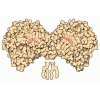[English] 日本語
 Yorodumi
Yorodumi- PDB-5e7w: X-ray Structure of Human Recombinant 2Zn insulin at 0.92 Angstrom -
+ Open data
Open data
- Basic information
Basic information
| Entry | Database: PDB / ID: 5e7w | ||||||
|---|---|---|---|---|---|---|---|
| Title | X-ray Structure of Human Recombinant 2Zn insulin at 0.92 Angstrom | ||||||
 Components Components | (Insulin) x 2 | ||||||
 Keywords Keywords | IMMUNE SYSTEM / Insulin / human / recombinant / high-resolution | ||||||
| Function / homology |  Function and homology information Function and homology informationnegative regulation of glycogen catabolic process / positive regulation of nitric oxide mediated signal transduction / negative regulation of fatty acid metabolic process / negative regulation of feeding behavior / Signaling by Insulin receptor / IRS activation / regulation of protein secretion / Insulin processing / positive regulation of peptide hormone secretion / positive regulation of respiratory burst ...negative regulation of glycogen catabolic process / positive regulation of nitric oxide mediated signal transduction / negative regulation of fatty acid metabolic process / negative regulation of feeding behavior / Signaling by Insulin receptor / IRS activation / regulation of protein secretion / Insulin processing / positive regulation of peptide hormone secretion / positive regulation of respiratory burst / negative regulation of acute inflammatory response / Regulation of gene expression in beta cells / alpha-beta T cell activation / positive regulation of dendritic spine maintenance / Synthesis, secretion, and deacylation of Ghrelin / negative regulation of respiratory burst involved in inflammatory response / activation of protein kinase B activity / negative regulation of protein secretion / negative regulation of gluconeogenesis / positive regulation of insulin receptor signaling pathway / positive regulation of glycogen biosynthetic process / fatty acid homeostasis / Signal attenuation / FOXO-mediated transcription of oxidative stress, metabolic and neuronal genes / negative regulation of lipid catabolic process / positive regulation of lipid biosynthetic process / negative regulation of oxidative stress-induced intrinsic apoptotic signaling pathway / regulation of protein localization to plasma membrane / nitric oxide-cGMP-mediated signaling / transport vesicle / COPI-mediated anterograde transport / positive regulation of nitric-oxide synthase activity / Insulin receptor recycling / negative regulation of reactive oxygen species biosynthetic process / positive regulation of brown fat cell differentiation / insulin-like growth factor receptor binding / NPAS4 regulates expression of target genes / neuron projection maintenance / endoplasmic reticulum-Golgi intermediate compartment membrane / positive regulation of mitotic nuclear division / Insulin receptor signalling cascade / positive regulation of glycolytic process / positive regulation of cytokine production / endosome lumen / positive regulation of long-term synaptic potentiation / acute-phase response / positive regulation of protein secretion / positive regulation of D-glucose import / insulin receptor binding / positive regulation of cell differentiation / Regulation of insulin secretion / wound healing / positive regulation of neuron projection development / hormone activity / negative regulation of protein catabolic process / regulation of synaptic plasticity / positive regulation of protein localization to nucleus / Golgi lumen / vasodilation / cognition / glucose metabolic process / insulin receptor signaling pathway / cell-cell signaling / glucose homeostasis / regulation of protein localization / PI5P, PP2A and IER3 Regulate PI3K/AKT Signaling / positive regulation of cell growth / protease binding / secretory granule lumen / positive regulation of canonical NF-kappaB signal transduction / positive regulation of phosphatidylinositol 3-kinase/protein kinase B signal transduction / positive regulation of MAPK cascade / positive regulation of cell migration / G protein-coupled receptor signaling pathway / endoplasmic reticulum lumen / Amyloid fiber formation / Golgi membrane / negative regulation of gene expression / positive regulation of cell population proliferation / positive regulation of gene expression / regulation of DNA-templated transcription / extracellular space / extracellular region / identical protein binding Similarity search - Function | ||||||
| Biological species |  Homo sapiens (human) Homo sapiens (human) | ||||||
| Method |  X-RAY DIFFRACTION / X-RAY DIFFRACTION /  SYNCHROTRON / SYNCHROTRON /  MOLECULAR REPLACEMENT / Resolution: 0.9519 Å MOLECULAR REPLACEMENT / Resolution: 0.9519 Å | ||||||
 Authors Authors | Lisgarten, D.R. / Naylor, C.E. / Palmer, R.A. / Lobley, C.M.C. | ||||||
 Citation Citation |  Journal: Chem Cent J / Year: 2017 Journal: Chem Cent J / Year: 2017Title: Ultra-high resolution X-ray structures of two forms of human recombinant insulin at 100 K. Authors: Lisgarten, D.R. / Palmer, R.A. / Lobley, C.M.C. / Naylor, C.E. / Chowdhry, B.Z. / Al-Kurdi, Z.I. / Badwan, A.A. / Howlin, B.J. / Gibbons, N.C.J. / Saldanha, J.W. / Lisgarten, J.N. / Basak, A.K. | ||||||
| History |
|
- Structure visualization
Structure visualization
| Structure viewer | Molecule:  Molmil Molmil Jmol/JSmol Jmol/JSmol |
|---|
- Downloads & links
Downloads & links
- Download
Download
| PDBx/mmCIF format |  5e7w.cif.gz 5e7w.cif.gz | 88.2 KB | Display |  PDBx/mmCIF format PDBx/mmCIF format |
|---|---|---|---|---|
| PDB format |  pdb5e7w.ent.gz pdb5e7w.ent.gz | 67.9 KB | Display |  PDB format PDB format |
| PDBx/mmJSON format |  5e7w.json.gz 5e7w.json.gz | Tree view |  PDBx/mmJSON format PDBx/mmJSON format | |
| Others |  Other downloads Other downloads |
-Validation report
| Arichive directory |  https://data.pdbj.org/pub/pdb/validation_reports/e7/5e7w https://data.pdbj.org/pub/pdb/validation_reports/e7/5e7w ftp://data.pdbj.org/pub/pdb/validation_reports/e7/5e7w ftp://data.pdbj.org/pub/pdb/validation_reports/e7/5e7w | HTTPS FTP |
|---|
-Related structure data
| Related structure data |  3w7yS S: Starting model for refinement |
|---|---|
| Similar structure data |
- Links
Links
- Assembly
Assembly
| Deposited unit | 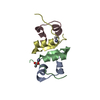
| ||||||||||||||||||
|---|---|---|---|---|---|---|---|---|---|---|---|---|---|---|---|---|---|---|---|
| 1 | 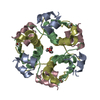
| ||||||||||||||||||
| Unit cell |
| ||||||||||||||||||
| Components on special symmetry positions |
|
- Components
Components
-Protein/peptide , 2 types, 4 molecules ACBD
| #1: Protein/peptide | Mass: 2383.698 Da / Num. of mol.: 2 Source method: isolated from a genetically manipulated source Details: Human Insulin A and C Chain Insulin was purchased from Insugen Source: (gene. exp.)  Homo sapiens (human) / Gene: INS / Production host: Homo sapiens (human) / Gene: INS / Production host:  Komagataella pastoris (fungus) / References: UniProt: P01308 Komagataella pastoris (fungus) / References: UniProt: P01308#2: Protein/peptide | Mass: 3433.953 Da / Num. of mol.: 2 Source method: isolated from a genetically manipulated source Details: Human Insulin B and D chain Insulin was purchased from Insugen Source: (gene. exp.)  Homo sapiens (human) / Gene: INS / Production host: Homo sapiens (human) / Gene: INS / Production host:  Komagataella pastoris (fungus) / References: UniProt: P01308 Komagataella pastoris (fungus) / References: UniProt: P01308 |
|---|
-Non-polymers , 4 types, 224 molecules 
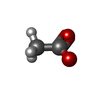





| #3: Chemical | | #4: Chemical | ChemComp-ACT / | #5: Chemical | ChemComp-POL / | #6: Water | ChemComp-HOH / | |
|---|
-Details
| Has protein modification | Y |
|---|
-Experimental details
-Experiment
| Experiment | Method:  X-RAY DIFFRACTION X-RAY DIFFRACTION |
|---|
- Sample preparation
Sample preparation
| Crystal | Density Matthews: 1.89 Å3/Da / Density % sol: 35 % / Description: needle |
|---|---|
| Crystal grow | Temperature: 293 K / Method: batch mode / pH: 6.3 Details: The crystals were prepared by a batch method similar to that of Baker et al, 1988 [1], modified as follows: 0.01g of insulin as a fine powder was placed in a clean test tube; 0.02M HCl was ...Details: The crystals were prepared by a batch method similar to that of Baker et al, 1988 [1], modified as follows: 0.01g of insulin as a fine powder was placed in a clean test tube; 0.02M HCl was added to dissolve the protein; on addition of 0.15 mL of 0.15 M zinc acetate the solution became cloudy due to precipitation of the protein; 0.3 mL of acetone and then 0.5 mL of trisodium citrate together with 0.8 mL of water were added and the solution went clear; the pH was checked and increased with NaOH to a pH between 8 and 9 for different batches, thus ensuring complete dissolution. It was then adjusted to the required value of pH 6.3. If any slight turbidity occurred, it was removed by warming the solution. The solution was then filtered using a Millipore membrane/acetate cellulose acetate filter. This removes any nuclei which will encourage precipitation or formation of masses of small crystals. The solution was then warmed to 50 deg C by surrounding the test tube with preheated water in a Dewar. This allowed the solution to cool slowly to room temperature. The test tube was lightly sealed with cling film; crystals formed within a few days and were of suitable size for X-ray diffraction within two weeks; the test tube containing crystals was kept at 4 degC prior to data collection. The crystal used for data collection was about 0.2 mm3. PH range: 6.2 - 6.4 / Temp details: Room Temperature |
-Data collection
| Diffraction | Mean temperature: 100 K |
|---|---|
| Diffraction source | Source:  SYNCHROTRON / Site: SYNCHROTRON / Site:  Diamond Diamond  / Beamline: I02 / Wavelength: 0.77 Å / Beamline: I02 / Wavelength: 0.77 Å |
| Detector | Type: DECTRIS PILATUS 6M / Detector: PIXEL / Date: Sep 27, 2012 Details: Data were collected at 16000keV (0.77 Angstrom) and 100 deg K with the Pilatus 6M detector as close to the sample as possible (179.5mm). The EDNA strategy was used to obtain a start angle ...Details: Data were collected at 16000keV (0.77 Angstrom) and 100 deg K with the Pilatus 6M detector as close to the sample as possible (179.5mm). The EDNA strategy was used to obtain a start angle and 180 deg of data were collected with 0.1 deg oscillation and 0.1s exposure. The resolution of useful diffraction data achieved and used for structure analysis was 0.92 Angstrom. |
| Radiation | Monochromator: Beamline fixed at 16000keV / Protocol: SINGLE WAVELENGTH / Monochromatic (M) / Laue (L): M / Scattering type: x-ray |
| Radiation wavelength | Wavelength: 0.77 Å / Relative weight: 1 |
| Reflection | Resolution: 0.92→40.91 Å / Num. obs: 58647 / % possible obs: 100 % / Redundancy: 5 % / Rmerge(I) obs: 0.034 / Net I/σ(I): 20.2 |
| Reflection shell | Resolution: 0.92→0.94 Å / Redundancy: 4.7 % / Rmerge(I) obs: 0.967 / Mean I/σ(I) obs: 1.6 / % possible all: 100 |
- Processing
Processing
| Software |
| ||||||||||||||||||||
|---|---|---|---|---|---|---|---|---|---|---|---|---|---|---|---|---|---|---|---|---|---|
| Refinement | Method to determine structure:  MOLECULAR REPLACEMENT MOLECULAR REPLACEMENTStarting model: 3W7Y Resolution: 0.9519→10 Å / Cross valid method: FREE R-VALUE / σ(F): 0
| ||||||||||||||||||||
| Displacement parameters | Biso mean: 18.45 Å2 | ||||||||||||||||||||
| Refinement step | Cycle: LAST / Resolution: 0.9519→10 Å
|
 Movie
Movie Controller
Controller


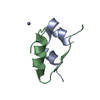
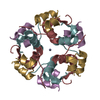
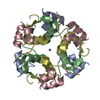
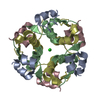

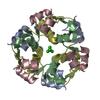
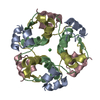
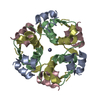
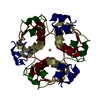
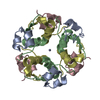

 PDBj
PDBj











